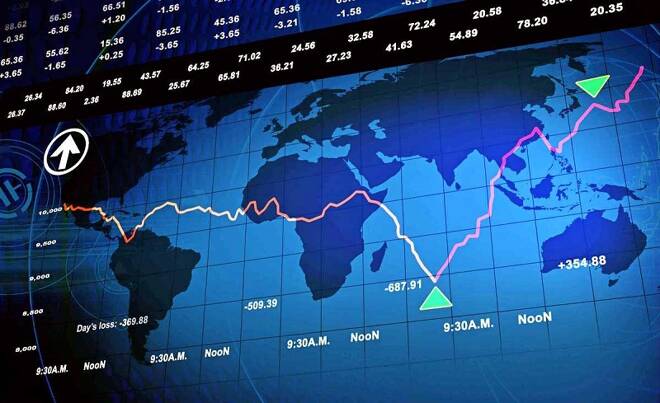Advertisement
Advertisement
Gold and The Cracks in The U.S., Japan and Germany’s Economic Data
By:
Talk of a synchronized world - all three economic superpowers are in a recession! The U.S. suffers from industrial recession, Japan from export recession, while Germany may fall into a broad economic recession. Will the gold market warm up to these news?
Recent U.S. Data Shows Industrial Recession
The recent inversion of the yield curve has sparked recessionary fears. Some of the newest pieces of the U.S. economic data confirm the gloomy outlook. For example, the industrial production fell 0.2 percent in July, the second drop in the past four months, according to the Federal Reserve, as one can see in the chart below. Although the scale of slump might be overstated due to the Hurricane Barry hitting oil production in the Gulf of Mexico, the industrial sector remains in a technical recession.
However, other recent economic reports have been more positive. The retail sales surged 0.7 percent in July, beating expectations. As the chart below shows, there is also an improvement on an annual basis. What is more, when omitting auto dealers and gasoline stations, retail sales scored an even stronger gain of 0.9 percent last month.
Chart 1: Annual percentage change in the US industrial production (green line) and the retail sales (red line) from January 2010 to July 2019.
Moreover, the CPI increased 0.3 percent in July after rising 0.1 percent in June, according to the BLS. The core CPI also rose 0.3 percent, the same increase as in June. On an annual basis, the overall inflation rate jumped 1.8 percent, an acceleration from 1.6-percent change in June, while the core CPI rose 2.2 percent over the last 12 months, slightly more than the 2.1-percent increase for the period ending June, as the chart below shows.
Chart 2: Annual percentage change in the US CPI (green line) and the core CPI (red line) from January 2015 to July 2019.
Although higher inflation is not good news for the consumers, it can soothe the nerves of doves among the FOMC and all those believing that subdued inflation is something bad for the economy. However, the markets still expect two more interest rate cuts this year – the modest acceleration in inflation notwithstanding. It’s the best fundamental combo for gold: higher inflation but still dovish Fed.
Japanese and German Exports Suffers
Although the factory sector is in technical recession, the U.S. economy looks on a much more solid footing than Japan or the Eurozone does. In the Land of the Rising Sun, the exports fell 1.6% from a year earlier, marking eighth decline in a row. At the same time, manufacturers’ confidence turned negative for the first time in over six years
When it comes to Germany, the Eurozone’s economic powerhouse, it might be already in recession. The GDP fell 0.1 percent in the second quarter of 2019. To make matters worse, the Bundesbank said on Monday that the German economy could have continued to shrink over the summer. The downturn stems from the weak industrial production amid a dearth of orders. The trade wars finally hit both export-focused economies. Although the services sector should provide the support for Germany (and Japan), there are some signs that the industrial downturn will be felt in the labor market.
Given that slump and the fact that inflation in the Eurozone is now running at 1 percent, the ECB could decide in September on further stimulus, perhaps even bigger than expected. It should weaken both the euro and gold against the U.S. dollar. However, it can also increase the safe-haven demand for gold, if the ECB’s action scares European investors.
Implications for Gold
What does it all mean for the gold market? On the other hand, the U.S. remains in much better shape than Japan or the Eurozone. This should support the U.S. dollar, creating downward pressure on the gold prices. On the other hand, the global slowdown may eventually spread into the U.S. one day. When the recession arrives to the States – and the yield curve inversions suggests that it is only a matter of time – gold should shine.
Thank you.
Arkadiusz Sieron
Sunshine Profits‘ Gold News Monitor and Gold Market Overview Editor
All essays, research and information found above represent analyses and opinions of Przemyslaw Radomski, CFA and Sunshine Profits’ associates only. As such, it may prove wrong and be a subject to change without notice. Opinions and analyses were based on data available to authors of respective essays at the time of writing. Although the information provided above is based on careful research and sources that are believed to be accurate, Przemyslaw Radomski, CFA and his associates do not guarantee the accuracy or thoroughness of the data or information reported. The opinions published above are neither an offer nor a recommendation to purchase or sell any securities. Mr. Radomski is not a Registered Securities Advisor. By reading Przemyslaw Radomski’s, CFA reports you fully agree that he will not be held responsible or liable for any decisions you make regarding any information provided in these reports. Investing, trading and speculation in any financial markets may involve high risk of loss. Przemyslaw Radomski, CFA, Sunshine Profits’ employees and affiliates as well as members of their families may have a short or long position in any securities, including those mentioned in any of the reports or essays, and may make additional purchases and/or sales of those securities without notice.
About the Author
Arkadiusz Sierońcontributor
Arkadiusz Sieroń, Ph.D., is an Assistant Professor at University of Wrocław. He is a certified Investment Adviser and a long-time precious metals market enthusiast.
Did you find this article useful?
Latest news and analysis
Advertisement
